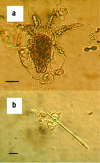Survival of Batrachochytrium dendrobatidis in water: quarantine and disease control implications
- PMID: 12967488
- PMCID: PMC3020615
- DOI: 10.3201/eid0908.030145
Survival of Batrachochytrium dendrobatidis in water: quarantine and disease control implications
Abstract
Amphibian chytridiomycosis is an emerging infectious disease of amphibians thought to be moved between countries by trade in infected amphibians. The causative fungus, Batrachochytrium dendrobatidis, produces aquatic, motile zoospores; infections have been achieved in experiments by exposing amphibians to water containing zoospores. However, the ability of this fungus to survive in the environment in the absence of an amphibian host is unknown. We show that B. dendrobatidis will survive in tap water and in deionized water for 3 and 4 weeks, respectively. In lake water, infectivity was observed for 7 weeks after introduction. The knowledge that water can remain infective for up to 7 weeks is important for the formulation of disease control and quarantine strategies for the management of water that has been in contact with amphibians.
Figures
References
-
- Pessier AP, Nichols DK, Longcore JE, Fuller MS. Cutaneous chytridiomycosis in poison dart frogs (Dendrobates spp.) and White’s tree frogs (Litoria caerulea). J Vet Diagn Invest. 1999;11:194–9. - PubMed
-
- Mutschmann F, Berger L, Zwart P, Gaedicke C. Chytridiomycosis in amphibians—first report in Europe [In German]. Berl Munch Tierarztl Wochenschr. 2000;113:380–3. - PubMed
-
- Bosch J, Martinez-Solano I, Garcia-Paris M. Evidence of a chytrid fungus infection involved in the decline of the common midwife toad (Alytes obstetricans) in protected areas of central Spain. Biol Conserv. 2001;97:331–7. 10.1016/S0006-3207(00)00132-4 - DOI
MeSH terms
LinkOut - more resources
Full Text Sources
Medical
Miscellaneous

